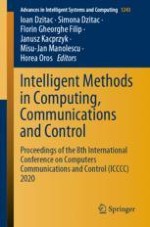2021 | Buch
Intelligent Methods in Computing, Communications and Control
Proceedings of the 8th International Conference on Computers Communications and Control (ICCCC) 2020
herausgegeben von: Prof. Dr. Ioan Dzitac, Simona Dzitac, Prof. Dr. Florin Gheorghe Filip, Prof. Janusz Kacprzyk, Prof. Dr. Misu-Jan Manolescu, Dr. Horea Oros
Verlag: Springer International Publishing
Buchreihe : Advances in Intelligent Systems and Computing

 (
( (unfortunately still gate-level constrained), and we report our preliminary findings in this paper.
(unfortunately still gate-level constrained), and we report our preliminary findings in this paper.